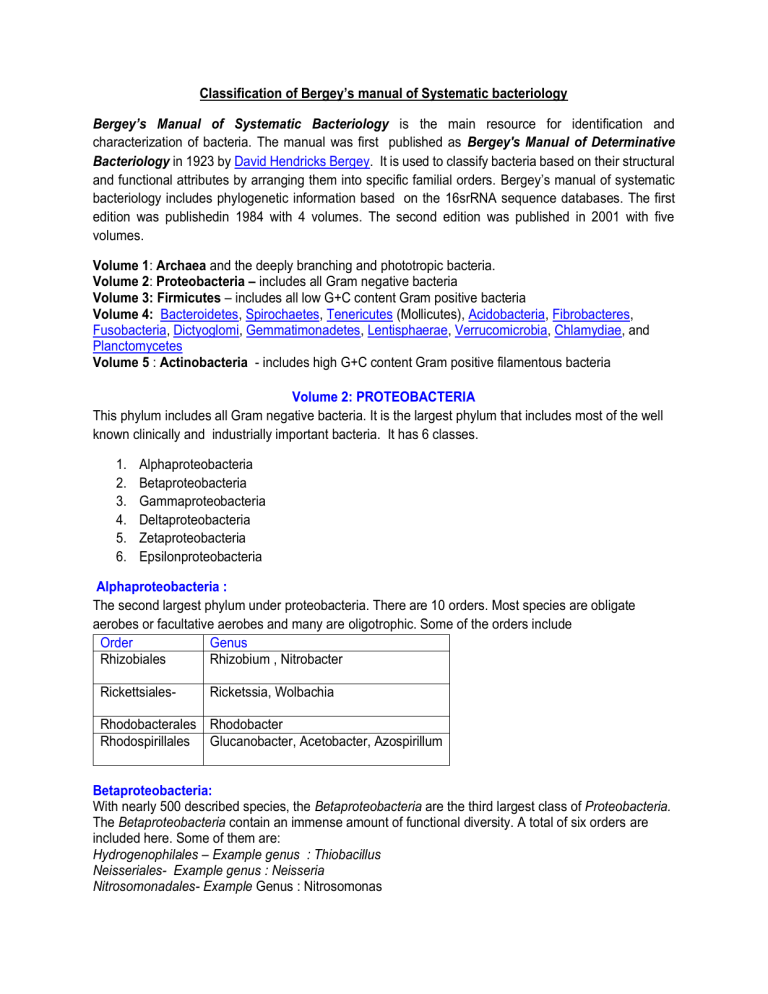
Classification of Bergey’s manual of Systematic bacteriology Bergey’s Manual of Systematic Bacteriology is the main resource for identification and characterization of bacteria. The manual was first published as Bergey's Manual of Determinative Bacteriology in 1923 by David Hendricks Bergey. It is used to classify bacteria based on their structural and functional attributes by arranging them into specific familial orders. Bergey’s manual of systematic bacteriology includes phylogenetic information based on the 16srRNA sequence databases. The first edition was publishedin 1984 with 4 volumes. The second edition was published in 2001 with five volumes. Volume 1: Archaea and the deeply branching and phototropic bacteria. Volume 2: Proteobacteria – includes all Gram negative bacteria Volume 3: Firmicutes – includes all low G+C content Gram positive bacteria Volume 4: Bacteroidetes, Spirochaetes, Tenericutes (Mollicutes), Acidobacteria, Fibrobacteres, Fusobacteria, Dictyoglomi, Gemmatimonadetes, Lentisphaerae, Verrucomicrobia, Chlamydiae, and Planctomycetes Volume 5 : Actinobacteria - includes high G+C content Gram positive filamentous bacteria Volume 2: PROTEOBACTERIA This phylum includes all Gram negative bacteria. It is the largest phylum that includes most of the well known clinically and industrially important bacteria. It has 6 classes. 1. 2. 3. 4. 5. 6. Alphaproteobacteria Betaproteobacteria Gammaproteobacteria Deltaproteobacteria Zetaproteobacteria Epsilonproteobacteria Alphaproteobacteria : The second largest phylum under proteobacteria. There are 10 orders. Most species are obligate aerobes or facultative aerobes and many are oligotrophic. Some of the orders include Order Genus Rhizobiales Rhizobium , Nitrobacter Rickettsiales- Ricketssia, Wolbachia Rhodobacterales Rhodobacter Rhodospirillales Glucanobacter, Acetobacter, Azospirillum Betaproteobacteria: With nearly 500 described species, the Betaproteobacteria are the third largest class of Proteobacteria. The Betaproteobacteria contain an immense amount of functional diversity. A total of six orders are included here. Some of them are: Hydrogenophilales – Example genus : Thiobacillus Neisseriales- Example genus : Neisseria Nitrosomonadales- Example Genus : Nitrosomonas Gammaproteobacteria: The Gammaproteobacteria are the largest and most diverse class of Proteobacteria, containing nearly half of the characterized species in the phylum. This class includes many of the well known human pathogens. The class contains more than 1500 characterized species among its 15 orders. The Order enterobacteriales consists of enteric bacteria, relatively homogeneous phylogenetic group within the Gammaproteobacteria and consist of facultatively aerobic, gram-negative, nonsporulating rods. Some of the important orders include: Order Enterobacteriales: Genus - Escherichia coli, Salmonella , Enterobacter, Klebsiella, Proteus Order Pseudomonadales: Genus – Pseudomonas Order: Vibrionales: Genus - Vibrio Order Xanthomonadales: Genus - Xanthomonas Delta, Epsilon and Zeta proteobacteria: The Deltaproteobacteria are primarily sulfate- and sulphur reducing bacteria and bacterial predators. Epsilonproteobacteria, contain many species that oxidize the H2S produced by the sulfate and sulfur reducers. The final class of Proteobacteria, the Zetaproteobacteria, contains only one characterized species (the iron oxidizer Mariprofundus ferrooxydans) . Deltaproteobacteria: Example – desulphobacter, myxococcales Epsilonproteobacteria :Example – campylobacter, helicobacter Zetaproteobacteria: Example – Mariprofundus ferrooxydans Volume 3 :FIRMICUTES Firmicutes are low GC content Gram positive bacteria. There are three major orders under firmicutes : • Lactobacillales • Bacillales • Clostridiales Order: Lactobacillales The order Lactobacillales contains the lactic acid bacteria, fermentative organisms that produce lactic acid as a major end product of metabolism. One important difference between subgroups of the lactic acid bacteria lies in the pattern of products formed from the fermentation of sugars. One group, called homofermentative, produces a single fermentation product, lactic acid. The other group, called heterofermentative, produces other products, mainly ethanol and CO2, as well as lactate. Eg: Lactobacillus,Leuconostoc Order: Bacillales: The order Bacillales typically contains aerobic and facultatively aerobic chemoorganotrophs. Few human pathogens are found within this group, but the genus Listeria is a notable exception. Several species of bacillales produce endospores. Eg: Bacillus, Listeria Order Clostridiales: A number of clostridia are saccharolytic and ferment sugars, producing butyric acid as a major end product. The main habitat of clostridia is the soil. Several Closridia are pathogenic andendospore producing. Eg: botulism is caused by Clostridium botulinum, tetanus by Clostridium tetani, and gas gangrene by Clostridium perfringens. Volume 5 : Actinobacteria The other major group of gram-positive bacteria is the Actinobacteria, which form their own phylum within the Bacteria. The Actinobacteria contain rod-shaped to filamentous and primarily aerobic bacteria that are common inhabitants of soil and plant materials. For the most part they are harmless commensals, species of Mycobacterium (for example, Mycobacterium tuberculosis) being notable exceptions. Some are of great economic value in either the production of antibiotics or certain fermented dairy products. While there are nine orders of Actinobacteria, the vast majority of species belong to the order Actinomycetales. Examples in Order Actinomycetales: • Mycobacterium tuberculosis : pathogen known to cause tuberculosis • Propionibcaterium sp: popular for swiss cheese production • Streptomyces griseus : production of antibiotic streptomycin Volume 1 :Archaea Archaea include species that carry out chemoorganotrophic or chemolithotrophic metabolisms, and both aerobic and anaerobic species are common Many metabolic traits of archaeal species are also found in Bacteria but others are unique to Archaea. Methanogens, for example, are Euryarchaeota that conserve energy from the production of methane. Archaea are also well known for containing many species of extremophiles, including species that are hyperthermophiles (organisms with growth temperature optima above 80°C), halophiles, and acidophiles. Examples: • Extremely halophilic archaea : salt loving – Halococcus • Methanogens – bacteria that produce methane- Methanospirillum, Methanobacterium • Extremely Acidophilic bacteria – Thermoplasma acidophilum • Hyperthermophilic bacteria - Thermococcus, Pyrococcus Volume 4 Volume 4 of Bergey’s manual contains several phyla with diverse characteristics. Among them are tenericutes, bacteriodetes, chlamydiae,planctomycetes and many other phyla. The Tenericutes, are bacteria that lack cell walls. This group is often called the mycoplasmas because Mycoplasma, a notable genus containing human pathogens. Mycoplasmas typically live in close association with animal and plant hosts and this may eliminate the need for a gram-positive cell wall. Mycoplasmas resemble protoplasts (bacteria treated to remove their cell walls), but they are more resistant at least partially due to the presence of sterols in their membrane. The phylum Bacteroidetes contains more than 700 characterized species spread across four orders. They are gram-negative nonsporulating rods; species are typically saccharolytic and can be aerobic or fermentative. Eg: Flavobacterium . The phylum Chlamydiae contains a single order, the Chlamydiales. The entire phylum consists of obligate intracellular parasites of eukaryotes. Eg: Chlamydia. Planctomycetes are gram-negative bacteria. Planctomycetes are unusual among bacteria because their cell walls lack peptidoglycan and hence are resistant to antibiotics. Eg: Planctomycetes. Source: Brock biology of microorganisms



